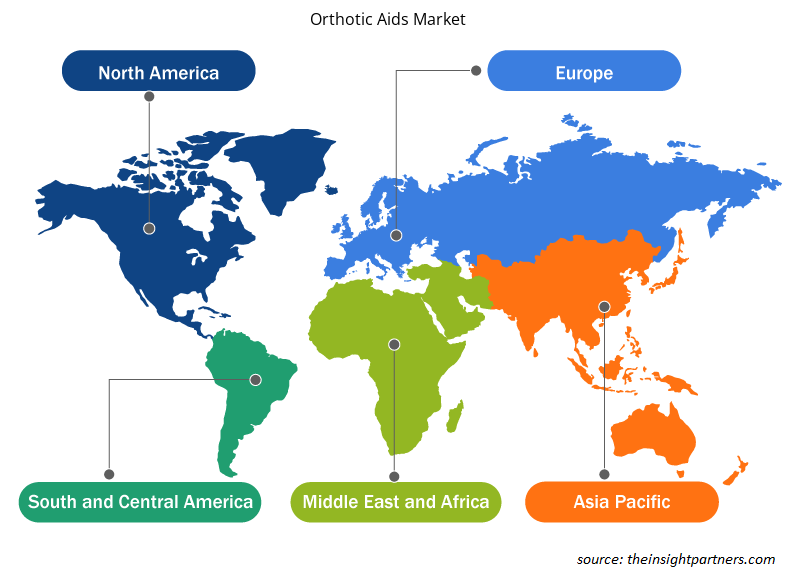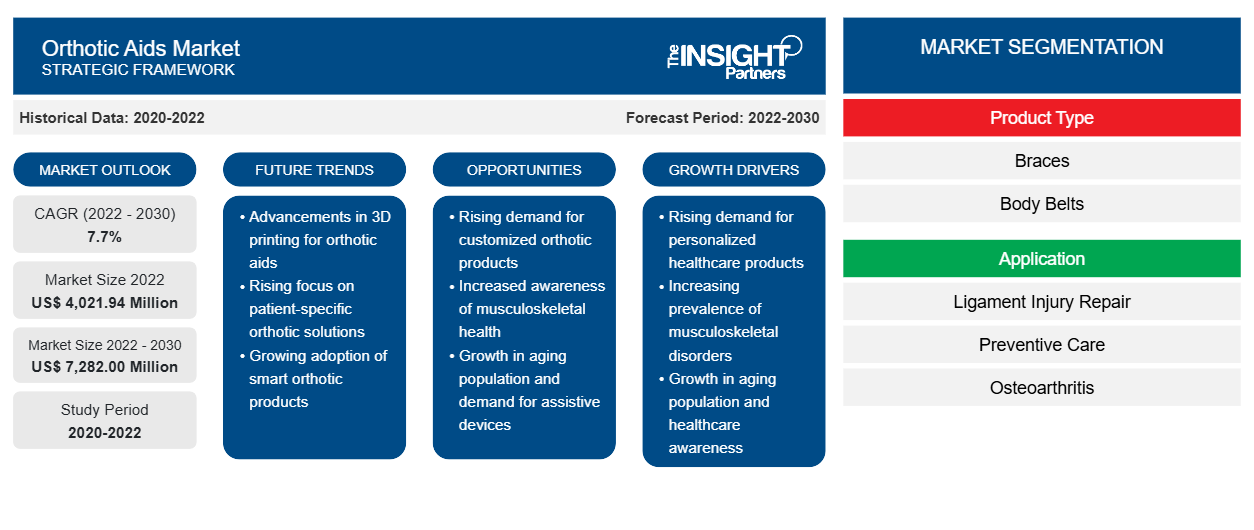[研究报告] 矫形辅助器市场规模预计将从 2022 年的 40.2194 亿美元增长到 2030 年的 72.82 亿美元;预计该市场在 2022-2030 年期间的复合年增长率为 7.7%。
市场洞察和分析师观点:
矫形辅助器具用于为肌肉骨骼系统提供支撑和稳定性;预防、矫正或调整畸形;以及改善身体部位的功能。一些常用的矫形辅助器具包括足部矫形器、膝盖支架、背部支架、腕部支架和踝部支架。全球大量人口的骨科疾病激增,增加了对矫形辅助器具的需求。此外,矫形器市场参与者不断增加的产品发布、技术进步和战略合作可能会在未来几年扩大矫形辅助器具市场的增长。
增长动力:
身体带和支架等矫形辅助器有助于脑瘫、脑损伤、脊髓损伤和其他神经/矫形疾病患者活动和支撑。根据美国疾病控制和预防中心的数据,2020 年美国报告了约 214,110 例创伤性脑损伤 (TBI) 相关住院病例和 69,473 例 TBI 相关死亡病例。因此,随着患有各种矫形和神经疾病的患者数量的增加,矫形辅助器的使用也在增加。
医疗设施的现代化和医疗服务的改善最终提高了人们的预期寿命,导致全球老年人口增加。老年人跌倒的风险更大,由于肌肉和骨骼会随着年龄的增长而磨损,轻微的事故也可能导致骨折或骨折。骨质疏松症和其他可能影响老年人的疾病可能会进一步增加骨折的风险。因此,老年人口的激增与骨科损伤和疾病数量的激增有关,从而产生了对矫形辅助器具的需求。根据骨关节炎 (OA) 行动联盟的数据,在美国,88% 的 OA 患者年龄至少为 45 岁,43% 的 OA 患者年龄在 65 岁或以上。
由于骨科和神经肌肉疾病(如脑瘫、脊柱裂、肌营养不良症和马蹄足)的影响,儿童的肌肉骨骼系统可能会以某种方式发育,导致运动和姿势困难。根据美国疾病控制和流行中心 (CDC) 的数据,马蹄足是美国最常见的先天性残疾之一,2022 年美国约有 6,643 名婴儿患有该疾病。儿科支撑涉及使用专门的矫形器或支架来支撑和调整儿童身体的关节,特别是脊柱、臀部、膝盖、脚踝和脚部的关节。这些设备是在诊断后开具的,通常是根据患者的需求制造的。
因此,各个年龄段的人群中矫形辅助器的使用增加推动了矫形辅助器市场的增长。
保险覆盖不一致或产品覆盖有限会导致患者的成本负担增加。矫形治疗和辅助器具的高成本以及不利的报销政策阻碍了矫形器具市场的增长。患有慢性疼痛或受伤的老年人可以从背部支架中受益匪浅。耐用的手臂、腿部、颈部和背部支架由医疗保险 B 部分承保,但有一些限制。医疗保险支架福利涵盖膝关节矫形器。矫形器必须是半刚性或刚性装置,用于支撑虚弱或变形的身体部位,或限制或完全排除患病或受伤的身体部位的运动,才有资格获得此福利的承保。支架福利的法定定义不适用于那些不够坚硬而无法固定或支撑其预期使用的身体部位的物品。不符合支架描述的物品不在承保范围内,也不符合此医疗保险福利的福利条件。
定制此报告以满足您的需求
您可以免费定制任何报告,包括本报告的部分内容、国家级分析、Excel 数据包,以及为初创企业和大学提供优惠和折扣
- 获取此报告的关键市场趋势。这个免费样品将包括数据分析,从市场趋势到估计和预测。
报告细分和范围:
“矫形辅助器市场”根据产品类型、应用、分销渠道、供应商类型和地理位置进行细分。根据产品类型,矫形辅助器市场细分为支架、身体带和其他。在应用方面,矫形辅助器市场细分为韧带损伤修复、预防保健、骨关节炎、压迫疗法和其他。根据分销渠道,市场分为线上和线下。根据供应商类型,矫形辅助器市场分为品牌和非品牌。根据地理位置,矫形辅助器市场分为北美(美国、加拿大、墨西哥)、欧洲(德国、英国、法国、意大利、西班牙、欧洲其他地区)、亚太地区(中国、日本、印度、澳大利亚、韩国、亚太其他地区)、中东和非洲(沙特阿拉伯、南非、阿联酋和 MEA 其他地区)以及南美洲和中美洲(巴西、阿根廷、南美洲和中美洲其他地区)。
节段分析:
按照产品类型,矫形辅助器具市场可分为支架、身体带和其他。支架部分在 2022 年占据了最大的市场份额。预计同一部分在 2022-2030 年期间的复合年增长率最高。背部牵引带、弹性背部支架、铜带、背痛带和背部支架等身体带通常用于治疗关节扭伤、肌肉拉伤和损伤。大多数人一生中都可能经历背痛。虽然受伤和疾病是背痛的几种原因之一,但很大一部分病例是由于不正确举起重物和姿势不良造成的。佩戴背部支架是预防背痛和改善姿势的常用方法。根据 Cross River Therapy 的数据,10 个美国人中有 8 个报告称一年内至少出现一次或多次背部问题。根据同一来源,8000 万工人(占所有就业美国人的 50%)每年报告背痛。
根据应用,矫形辅助器市场细分为韧带损伤修复、预防护理、骨关节炎、压迫疗法等。韧带损伤修复部分在 2022 年占据最大市场份额,预计 2022-2030 年复合年增长率最高。内侧副韧带 (MCL)、后交叉韧带 (PCL)、前交叉韧带 (ACL) 和外侧副韧带 (LCL) 是膝盖中的四条主要韧带。韧带对于保持膝盖活动至关重要,轻微的损伤也会给人带来很大的不适。膝关节支架可以减轻膝盖的负荷。如果出现部分撕裂,医生可能会建议使用 ACL 支架和物理疗法进行非手术修复 ACL 撕裂以增强肌肉。然而,对于接受手术的患者,医生建议佩戴术后护膝和拐杖,直到伤口完全愈合。ACL 撕裂的康复过程相对较长,可能需要 6 个月到 1 年才能完成。康复后,医生可能会建议患者在运动时佩戴 ACL 护膝。
PCL 撕裂分为四类:1 级撕裂、2 级撕裂、3 级撕裂和健康 PCL。如果撕裂严重,患者可能需要接受 PCL 手术。手术后,建议患者佩戴 PCL 护膝以进行术后恢复。Brace Ability 提供多种护具和支撑物,用于预防和治疗 PCL 撕裂。大多数 MCL 损伤可以在家中通过冰敷、消炎药物和休息进行治疗。医生可能会建议佩戴有助于保护患者膝盖并允许一定活动范围的护具。如果撕裂非常严重,患者可能需要手术。
根据分销渠道,矫形辅助器市场分为线上和线下。线下市场在 2022 年占据了更大的市场份额。然而,预计线上市场在 2022-2030 年期间的复合年增长率会更高。在线药店允许客户购买处方药、医疗设备和电子服务,而无需前往实体店,使他们能够在家中快速舒适地获得药物或服务。互联网普及、数字化、政府支持、经济蓬勃发展等是促成矫形辅助器市场通过在线分销渠道增长的主要因素。例如,沃尔玛和 Medical Department Store, Inc. 是提供支架、身体带、臂带等的少数在线分销商。
根据供应商类型,矫形辅助器市场分为品牌和非品牌。品牌部分在 2022 年占据了更大的市场份额;然而,预计非品牌部分在 2022-2030 年期间的复合年增长率会更高。品牌矫形辅助器包括由在全球具有重要影响力的知名制造商生产的产品;这些产品通过线上和线下分销渠道提供。美国是全球第二大护膝进口国,其大部分护膝来自中国、越南和比利时。发展中经济体制造商数量有限,消费者购买力不断提高,这鼓励品牌商品制造商提供满足不断变化的消费者需求的产品。
区域分析:
全球矫形辅助器市场分为北美、欧洲、亚太地区、中东和非洲以及南美和中美。由于骨科疾病在大量人口中患病率不断上升,以及易患此类疾病的老年人口数量激增,北美预计将占据主要市场份额。此外,产品发布、地域扩张和技术进步预计将在未来推动该地区矫形辅助器市场的增长。北美矫形辅助器市场分为美国、加拿大和墨西哥。美国占据主要市场份额。骨关节炎行动联盟 (OAAA) 指出,关节炎是美国的一个严重健康危机。根据美国疾病控制与预防中心 (CDC) 的估计,2019-2021 年期间,美国有 5320 万成年人(即约 25% 或四分之一的人)患有某种形式的关节炎,预计到 2040 年这一数字将达到 7800 万。关节炎和相关疾病有 100 多种形式。骨关节炎 (OA) 患者比同龄人经历更严重的疼痛、致残、疲劳和活动受限。慢性和发作性疼痛可导致功能障碍和工作受限。关节炎的特征是一个或多个关节压痛和肿胀。关节炎的主要症状包括僵硬和关节疼痛,通常会随着年龄的增长而恶化。矫形辅助器具(如膝关节支架)可以帮助缓解疼痛,并在不使用药物的情况下为关节或身体部位提供保护和支撑。背部支架可增强肌肉和上身力量,从而降低骨质疏松性骨折的风险。
美国脊髓损伤发病率的不断上升推动了矫形辅助器具市场的发展。根据美国神经外科医师协会的数据,美国每年有近 17,000 例新的脊髓损伤病例。美国国家多发性硬化症协会表示,2020 年美国约有 100 万人患有多发性硬化症。因此,脊髓损伤和多发性硬化症导致的残疾需要矫形辅助器具来帮助这些患者实现活动。医生建议脊髓损伤 (SCI) 患者使用支架。支架从外部调整脊柱位置,在软组织(如韧带)无法稳定脊柱时稳定脊柱,施加矫正力并限制运动。
预计 2022-2030 年期间,亚太地区的矫形辅助器具市场将实现显著的复合年增长率。预计市场增长的原因是老年人口不断增加,老年人口易患各种骨科疾病。中国是老年人口最多的国家之一。根据 2023 年人口参考局的数据,到 2050 年,中国老年人口预计将达到 3.66 亿,大大超过美国。此外,市场参与者之间的合作、技术进步和产品发布将进一步推动亚太地区矫形辅助器具市场的增长。2023 年 1 月,Breg, Inc. 与医疗器械供应商 Coreal International 合作,将其广泛的支撑和冷疗产品组合带给中国医生及其患者。
矫形辅助器市场区域洞察
Insight Partners 的分析师已详尽解释了预测期内影响矫形辅助器市场的区域趋势和因素。本节还讨论了北美、欧洲、亚太地区、中东和非洲以及南美和中美洲的矫形辅助器市场细分和地理位置。

- 获取矫形辅助器具市场的区域特定数据
矫形辅助器具市场报告范围
| 报告属性 | 细节 |
|---|---|
| 2022 年市场规模 | 40.2194亿美元 |
| 2030 年市场规模 | 72.82 亿美元 |
| 全球复合年增长率(2022 - 2030 年) | 7.7% |
| 史料 | 2020-2022 |
| 预测期 | 2022-2030 |
| 涵盖的领域 | 按产品类型
|
| 覆盖地区和国家 | 北美
|
| 市场领导者和主要公司简介 |
|
市场参与者密度:了解其对商业动态的影响
矫形辅助器具市场正在快速增长,这得益于终端用户需求的不断增长,而这些需求又源于消费者偏好的不断变化、技术进步以及对产品优势的认识不断提高等因素。随着需求的增加,企业正在扩大其产品范围,进行创新以满足消费者的需求,并利用新兴趋势,从而进一步推动市场增长。
市场参与者密度是指在特定市场或行业内运营的企业或公司的分布情况。它表明在给定市场空间中,相对于其规模或总市场价值,有多少竞争对手(市场参与者)存在。
在矫形辅助器具市场运营的主要公司有:
- 奥索高频
- 奥托博克股份公司
- 瑞士苏黎世电信公司
- 菲劳尔有限责任公司
- Lohmann & Rauscher 有限公司
免责声明:上面列出的公司没有按照任何特定顺序排列。

- 了解矫形辅助器具市场的主要参与者概况
行业发展和未来机遇:
以下列出了矫形辅助器具市场的主要参与者采取的各种举措:
- 2023 年 10 月,OrthoPediatrics Corp. 推出了 DF2 支架,作为其非手术业务扩张的一部分。该产品适用于治疗患有肌肉骨骼损伤的儿童。该支架旨在取代 6 个月至 5 岁儿童患者股骨骨折固定中的人字形石膏,从而固定股骨、膝盖和髋部。
- 2021 年 2 月,Breg, Inc. 推出了两条新的脊柱矫形器系列:Pinnacle 和 Ascend。这两条产品线共包含 15 种产品,旨在提高脊柱损伤患者的护理水平。
竞争格局和重点公司:
Ossur hf、Ottobock SE & Co KGaA、Thuasne SAS、Fillauer LLC、Lohmann & Rauscher GmbH & Co KG、DeRoyal Industries Inc、Hanger Inc、Steeper Group Holdings Ltd、Breg Inc 和 DJO LLC 是知名的矫形辅助器具公司。这些公司专注于新技术、现有产品的改进和地域扩张,以满足全球日益增长的消费者需求。
- 历史分析(2 年)、基准年、预测(7 年)及复合年增长率
- PEST和SWOT分析
- 市场规模、价值/数量 - 全球、区域、国家
- 行业和竞争格局
- Excel 数据集
近期报告
客户评价
购买理由
- 明智的决策
- 了解市场动态
- 竞争分析
- 客户洞察
- 市场预测
- 风险规避
- 战略规划
- 投资论证
- 识别新兴市场
- 优化营销策略
- 提升运营效率
- 顺应监管趋势





















 获取免费样品 - 矫形辅助器市场
获取免费样品 - 矫形辅助器市场